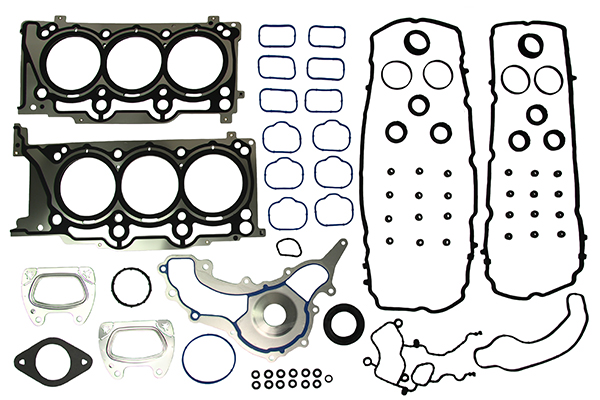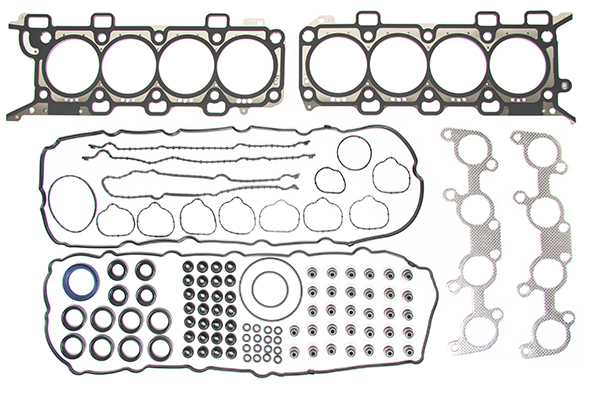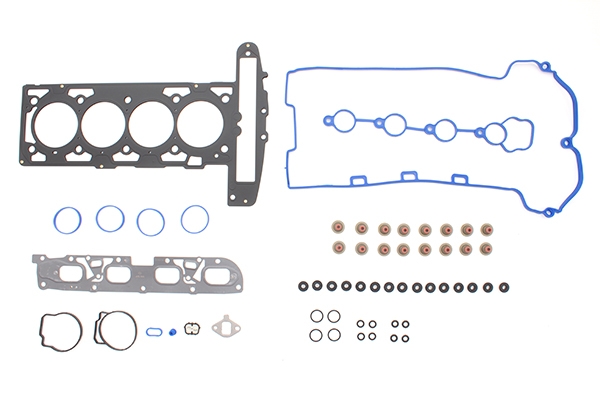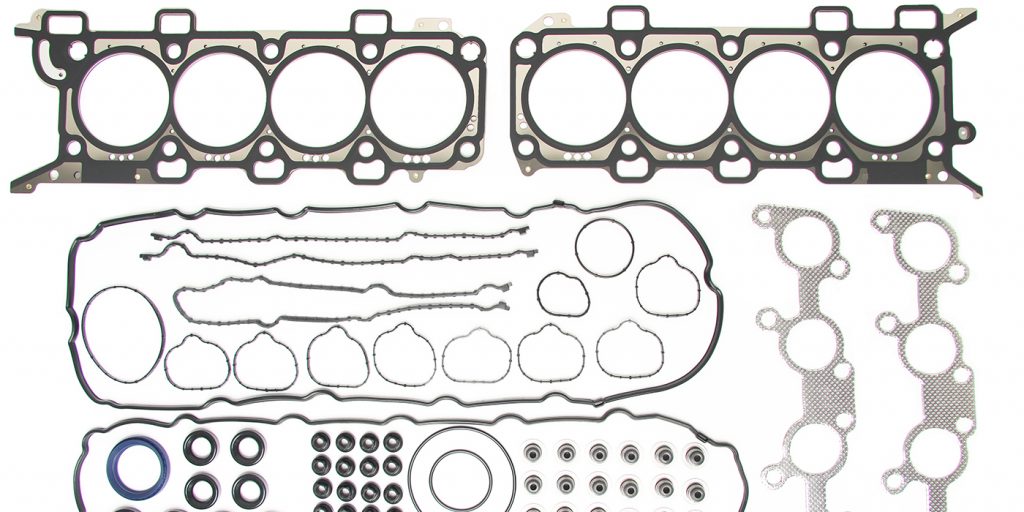Cork and rubber? I know it’s certainly not the common gasket material of the 21st century, but it once was a popular combination for engine sealing, and it makes for a great title.
When I drew the straw to look deeper into the world of engine sealing, I decided to leave out head gaskets. They are certainly in a world of their own, but many times over the years I’ve seen a lot of money spent getting the best head gaskets, but budget strings pulled on everything else, so it’s time to give the rest of the gaskets and seals their due.
Gasket Construction
Modern engines have taken us a long way from traditional gasket and seal design, and advancements in the technology and composition of rubber as well as advancements in molding processes have brought sealing capabilities to a new level.
A great deal of gasket and seal development starts with the research and chemistry of the materials. “An important part of modern gasket design is finding the optimal rubber material that is suitable for an aftermarket replacement gasket,” said Joseph Lin, vp of marketing for Safety Auto Parts.
Overall, gasket manufacturers share the same outlook about modern gasket design. “There are some changes in chemistry but there are also technology changes on the metal side of things with fiber gaskets and their inherent cores,” said Mike Hupertz of Cometic Gasket.
“We really try to stay true to the materials that we know work, making sure the materials we get are right and the chemistry is right for the application,” said Kristen Damberger of Cometic Gasket.

One of the more common seals being utilized by OE manufacturers is extruded rubber that fits into a machined groove. “The rubber is a very specific material with a very specific diameter and its reaction to heat and cool is critical,” said Bill Atkinson, sales manager of ElringKlinger. “You have to make sure when it cools, it still creates a strong seal and when it heats up, it doesn’t over-expand and deform the gasket.”
Elastomerics refers to the science of the rubber used in manufacturing seals and when referring to seals as well as flat gaskets and the seals that are designed into them. Tim Golema of Mahle said, “The chemistry of the substances, depending on the application, is probably the newest spin on the technology world because of temperature, fuel dilution and a whole variety of issues.”
Another change in technology has been advancements resulting in three-dimensional flashless molding. “Literally, when the mold opens, the seal is ready to use,” Golema says. “Before, there would be somebody trimming it or tumbling it to remove the flashing. We just don’t have to do that anymore. You can also mold three-dimensional pieces that are extremely small so you can seal with a limited amount of load and rigidity to the material.”
Performance or Not?
Are gaskets and seals intended for high-performance engines really different than those used as OE replacements or street builds? The answer is more than a simple yes or no, and it can almost be like opening Pandora’s box, but the easiest answer to avoid spiraling down a black hole is yes.
Part of the answer lies in material. “The rubber that is selected as the medium for the gasket is different for performance applications,” Lin says.
Gasket manufacturers agree that while they always encourage the use of high-quality gaskets, lower grades are available, but only those that are constructed of the best materials are the ones that represent a performance line. “We offer different levels of gasket quality; material being the difference,” Damberger says.
Cost is naturally a factor and is more commonly a consideration when overall price is a concern of the customer. “There is a demand for low-cost gaskets, that’s part of the nature of the business – to drive down costs, but it doesn’t mean that the product is unusable or unsuitable,” Lin says.

The cost of a gasket or seal is not a reflection of the manufacturing process or the intention of a manufacturer to offer high-quality, but still has an immediate effect on how well it works. “The vast majority of the cost in gaskets is in the material. Once you sacrifice the material integrity, the wheels will come off,” Golema says.
Material quality aside, the nature of a performance application is a sometimes-overlooked factor in selecting the correct gasket or seal. “Most automotive applications generally run with positive pressure in the crankcase, however, in some forms of racing, circle track for example, they are running a negative pressure in the crankcase, which completely changes gasket design,” Golema says. “There are seals that are designed to adapt to the environment of negative pressure sucking on the gasket rather than pushing on it.”
Also, a constant area of research is the topic of frictional losses in performance engine building. “Seals are a big area to reduce friction loss. Tremendous amounts of power are lost because of the friction of a seal,” said Aaron Hunter, vp of sales and marketing, Athena-SCE Inc.
The Cork-Rubber Connection
Old-school cork-rubber is still lurking in the shadows, but without the popularity it once had. “We don’t see cork gaskets used from 2000 and up, and we haven’t seen cork materials used on import applications since the mid-’90s,” says Lin.
This is because of the technology of new engines as well as gasket materials and manufacturing, but cork and cork-rubber still have their place in restorations. “There is newer technology and better technology, but we still offer a cork material for the folks who have to have it and want to have it. Maybe they are doing a restoration or something that needs to be period correct,” Hupertz says.
Gasket manufacturers such as Cometic Gasket, will offer custom gaskets, which is an added benefit to those looking for cork-type gaskets or others not commonly made. “We are really good at custom stuff and not adding to the cost because of the processes that are put in place,” Hupertz says.
Damberger added, “The beauty of the cork and the way we manufacture those gaskets is that we can cut it any shape you want at any point in time.”
Sealers and Adhesives
A topic that needs no introduction is a line of products that can save the day or ruin it – it all comes down to knowing the products and using them correctly. Sealers and Room Temperature Vulcanizing (RTV) silicones have left an impression on us all – be it good when we are successful with them, or bad when we’re not, to downright horrific when we raise the hood on a vehicle only to see it squeezing out of every crack and crevice.

A lot of OEs are using sealers during production for the efficiency they add to the process, and technology has improved them to the point where they are extremely effective at sealing.
“A lot of gaskets are evolving into liquid sealers because it is much easier for automated arms to dispense the liquid than it is for them to pick up a flimsy gasket and put it on, and there are a lot of production robots building motors,” says Atkinson. “Many things are taken into account when designing a sealer, including sealing area and hot/cold temperature variation. Sealers must hold on during vibration and separation. They must fill a gap and hold in compression, but also hold in a contraction.”
Sealers have come a long way from just silicone. “At the design level, the chemical sealers are an application-driven liquid more specific to the need,” Atkinson says. “A professional-grade sealer has more additives on the inside. There are more active pieces; it’s not just a silicone anymore.”
Some sealers are designed to be used sparingly, some are designed to fill, and the only way to ensure success is to use the right sealer for the right application and to follow the usage instructions exactly. “The confidence in using the right sealer helps in the confidence of the build,” he says.
Using the correct sealer for the application is as critical as any other part of engine building. “Use the correct sealer and don’t mix them,” says Golema. “Don’t inadvertently think because you have a little of something left that you can use it or combine it … it may come back to haunt you.”
Most gasket kits come with the correct sealer when it is necessary. “We will provide RTV in the kit when we deem it necessary,” Golema says. “If we think it needs to be there, we’ll supply it.”
As important as using the correct sealer is in following the instructions for application, if a sealer calls for a certain size of bead, always heed the requirements. Too much may not cure properly and go places it shouldn’t, too little may not cover the areas it needs to.
Remember, sealers are not all the same. Some are designed to fill areas; some are designed to grab and adhere. Using sealers as a solution to solve a leak may not be the answer. If it wasn’t originally designed for a sealer, you may have other problems.
“Silicones and sealers have their uses, such as the end seals on an old school intake, but generally speaking, if you have to use one to make something seal, it is a good possibility that the two sealing surfaces are no longer parallel,” Hunter says.
New Seal Design
Gaskets and seals are no longer designed as stand-alone products. “When an engine is designed, the gasket is part of the system, and the integration of the technology of sealing is more important today than it ever was,” Golema says. “In the old days, gasket companies worked off a few basic materials: one for intake gaskets, one for exhaust gaskets and one for head gaskets. Because of many factors, including materials, bolt load changes and the number of fasteners used, that strategy doesn’t work today.”
Many companies work directly with OEs to engineer modern gaskets and sealing solutions, and it is a process that is far more complex than meets the eye. “We do some things for OEs, and material choice plays a big role in noise, vibration and harshness,” Hupertz says.
For many years, multi-piece gaskets were the OE designs, but with the technology of molded rubber gaskets, many of these are being modernized into a one-piece seal. “Multi-piece gaskets being replaced by one-piece gaskets is something that is driven by demand,” Damberger says. “We still offer original gaskets, for example a four-piece oil pan gasket, but some folks prefer the newer stuff. With a one-piece gasket, you’re eliminating the sealer and the path for a leak.”
Gasket manufacturers work with engine builders and rebuilders on a regular basis to research sealing problems and engineer a solution. “If we recognize a problem with a seal design, we’ll look at it and come up with a design that is more robust and works in that environment by looking at the engine as a complete unit versus a particular component,” Hupertz says.
“In some cases, seals are designed for OE applications that originally were assembled with a sealer,” Hunter says. “We talk to the engine builders and determine how thick of a gasket we can make, and what other components will be affected. If it has to be a thin gasket, we have to get really creative with the material and also the bead seals or coatings that we put on it. In many cases, engine builders are requesting gaskets because they do not want to glue things back together.”
Intake Gaskets
Many intake gaskets still hold the appearance and misconception of being paper. “Paper gaskets, as they are sometimes known, are not just paper,” Hunter says. “They can contain aramid fibers and Kevlar fibers as well as rubbers that are designed to vulcanize in use.”
The bead seals on many intake gaskets are printed silicones. They are solids when they cure, which means they don’t compress. The important part to remember during installation is they have to displace something else, which results in a transfer of more clamp load to your intake ports or water ports, and not along the body of the gasket.

“Bead seal placement is critical on intake gaskets and when designing them, you consider all the variables of your intake gasket ports, including shapes from different aftermarket and performance components,” he says. “The width of a bead seal is also critical because what we have learned through analysis is how our clamp load is being tripped across the surface of an area. In some cases, the surfaces will deflect and pull away from each other, and we learn quickly where we need to add extra bead seal to prevent this from occurring.”
PTFE Seals
We all know the secret ingredient polytetrafluoroethylene (PTFE) that revolutionized many markets in the 20th century. One of the big issues confronting the automotive industry today is with PTFE crank or cam seals that have grown in application.
“With a traditional elastomeric crank or cam seal, you wipe a little oil on it so you don’t burn the sealing lip off, but if you do that with PTFE, it will leak immediately, because that’s not how it works,” Golema says. “The material works as long as the surface is dry and clean. You must clean it with denatured alcohol or brake clean. You cannot use carb clean because it contains petroleum distillates. The PTFE works by transferring itself to the shaft. Then you are running PTFE on PTFE and it will go forever. But they are moving away from it because they’ve had so many installation problems in the field.”
Golema went on to explain that it’s common on a transmission job to replace the rear main seal as a preventative measure, and this was great with a traditional elastomeric crank seal, but if a PTFE seal is incorrectly installed, then it creates an instant problem.
“It’s a field issue of a relatively new material that has come back to haunt many people who aren’t aware of the installation requirements,” Golema says. “It’s in all the instructions. People just don’t read it until after they make a mistake.”
On the diesel side, an interesting aspect of PTFE seals is that EPA regulations require some diesels to meet a static test where they put low pressure inside the engine and monitor it for a decay of pressure. The problem is that since the engine must be fired for the PTFE to transfer to the shaft, it will not seal on a new engine. What has been done to some of the seals is the addition of a traditional elastomeric bead on the outside.
“It’s a sacrificial lip,” Golema says. “All it is for is the snooper test, not the sealing.”
As is the case with any time you’re sealing an engine, cleanliness and preparation of the area is the key. After that, ensure you’re following the proper torque methods and torque loads for the specific gasket. And, when in doubt, the gasket manufacturers are always a great resource.
Article courtesy of Engine Builder magazine.














